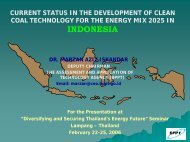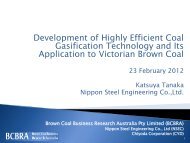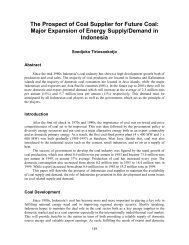Defining CCS Ready: An Approach to An International Definition
Defining CCS Ready: An Approach to An International Definition
Defining CCS Ready: An Approach to An International Definition
- No tags were found...
You also want an ePaper? Increase the reach of your titles
YUMPU automatically turns print PDFs into web optimized ePapers that Google loves.
Chapter 3: Transport <strong>Ready</strong> Plant <strong>Definition</strong>that a specific <strong>CCS</strong>-related regula<strong>to</strong>ry body can integrate all regula<strong>to</strong>ry aspects of <strong>CCS</strong><strong>Ready</strong> and <strong>CCS</strong> in the future, including transport and s<strong>to</strong>rage readiness.In addition <strong>to</strong> regulations, the government also might choose <strong>to</strong> have a role in financing andconstructing CO 2 pipelines as a means of accelerating their development. Until the economicgap is closed between the cost of <strong>CCS</strong> and the price of carbon, government participation maybe needed <strong>to</strong> potentially finance and, possibly, take an equity position in the development oflarger CO 2 pipeline networks. In general, it is expected that the experience of building naturalgas and oil pipeline infrastructure across the world over the past 80 years will provide someguidance for building a CO 2 pipeline network in any jurisdiction.If large volumes of CO 2 are <strong>to</strong> be s<strong>to</strong>red, a large pipeline network will likely be needed.Coordinated development of CO 2 pipeline networks by interested parties—possibly undergovernment oversight—could have a number of advantages, including: 84• The potential of higher volumes per individual line segment leading <strong>to</strong> lower per-unitcosts;• Reduced proliferation of pipelines with a lower environmental footprint;• The number of s<strong>to</strong>rage sites can be minimized and thus those candidates with the bestgeotechnical quality can be given priority; and• <strong>An</strong> open-access pipeline can provide fair space allocation <strong>to</strong> smaller entities, along withmultiple EOR markets and supply points <strong>to</strong> provide choice and volume security <strong>to</strong>participants.It is feared that opera<strong>to</strong>rs will be unable <strong>to</strong> exploit economies of scale due <strong>to</strong> lack ofcoordination and capital, 85 and smaller pipelines may be built due <strong>to</strong> short-term commercialpressures. Supplementing such smaller pipelines <strong>to</strong> meet an increase in the volume ofsequestered CO 2 would result in a higher lifetime system cost. Coordination may thus berequired <strong>to</strong> facilitate a more optimum initial sizing of the transport infrastructure. A centralinstitution overseeing CO 2 pipeline networks would be beneficial <strong>to</strong> improve coordinationamong parties.For example, as part of the EU Flagship Programme of 12 European <strong>CCS</strong> demonstrationplants, the European Technology Plant for Zero Emission Fossil Fuel Power Plants (ZEP) hasencouraged a plan for a continental CO 2 transport network. It is thought that regional“mainline” pipelines with a high CO 2 volume capacity will accept a supply from contribu<strong>to</strong>rypipelines from a range of EU member states. It is also thought that the basic CO 2 pipelineinfrastructure may mimic the network of natural gas pipelines in Europe <strong>to</strong>day, albeit withfewer subsidiary connections. 8684 Alberta Carbon Capture and S<strong>to</strong>rage Development Council. (2009). Accelerating carbon capture and s<strong>to</strong>rageimplementation in Alberta (Final Report). Edmon<strong>to</strong>n, Alberta: Author.85 NERA Economic Consulting. (2009). Developing a regula<strong>to</strong>ry framework for <strong>CCS</strong> transportation infrastructure (vol. 1 of 2)(Report no. URN 09D/596). London, UK: Author.86 Coleman, D.L.. (2009). Transport infrastructure rationale for carbon dioxide capture & s<strong>to</strong>rage in the European Union <strong>to</strong>2050. Energy Procedia, 1, 1673-1681. doi:10.1016/j.egypro.2009.01.219.23 February 2010 47
















